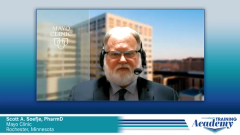
Treatment Considerations With Bispecifics in Multiple Myeloma
Panelists provide a broad-view perspective on established treatment pathways with bispecifics in multiple myeloma and the most prevalent challenges tied to this class of therapy.
Episodes in this series

Transcript:
Cesar Rodriguez, MD: Toelaborate a little more, Kirollos, how are you using teclistamab in your practice?
Kirollos S. Hanna, PharmD, BCPS, BCOP: You brought up a really good point. This landscape in myeloma has blown up in the past couple of years, particularly with BCMA-targeted therapies, CAR [chimeric antigen receptor] T cells, and bispecifics. It’s also important to highlight that we also lost the BCMA agent. From the DREAMM-3 trial, belantamab had its indication pulled from the market. But I’m optimistic that it will come back at a later time. Teclistamab has been really exciting. As many of our attendees probably know, the bispecifics have adverse event profiles that we have to be cognizant of. It’s interesting to see across the country what different individuals are doing based on the resources available within the health system. We have Mayo Clinic and Cedars-Sinai, large academic centers, and hospital support. I work as part of a very large community practice, but we’re not affiliated with or don’t own any hospital systems. That has posed some challenges. For us, CAR T-cell therapies are often off the market. They’re not something we can safely do within our organization. We don’t have that infrastructure, and data are somewhat limited. Although some institutions are doing CAR T-cell therapies in the outpatient setting, we don’t feel we’re equipped enough to participate in that model.
When we look at the dosing schedule for teclistamab, at this point in time, it’s given weekly. You have a ramp-up dosing schedule, then transition patients to a weekly administration. When you look at the recommendation and the REMS [Risk Evaluation and Mitigation Strategy] program available around teclistamab, the recommendation is that patients should be initiated during that ramp-up phase within a hospital setting. At Minnesota Oncology, a lot of our patients who are in therapy have said, “Could I come and receive my care in a community setting?” Within the state of Minnesota, we have 3 health systems that can safely initiate patients that I’m aware of: the University of Minnesota, Allina Health, and Mayo Clinic, all of which initiate and work with patients a little differently.
If a patient is eligible for something like teclistamab—4 prior lines of therapy, multiple relapses—our providers are working with their care coordinators, or their nurses are working with providers at those respective institutions, trying to establish care for that patient. Many of our patients go to Mayo for a second opinion. This far into myeloma treatment, there are many ways to approach care for patients…. When it’s time for a patient to transition back to the community—whether it’s through Mayo, University of Minnesota, or whatever—if they desire to come back to us at Minnesota Oncology, we can safely administer it. We’ve had several patients fall into this bucket, who are coming to us in the community setting or the outpatient setting after they’ve safely ramped up in the hospital. Because of limitations in staff training and documentation requirements, like most institutions, we restrict the administration of teclistamab to 1 of our 13 clinics. The other health systems—Mayo Clinic is unique—also restrict administration to a certain hospital within those systems, although there are multiple hospitals within the system. Cesar, is anything different on your end?
Cesar Rodriguez, MD: You bring up a very good point. Multiple questions are arising with these new immunotherapies. Who can give it? How much does it cost? What are the limitations for this agent to be given in the community vs an academic center or a large institution? One limitation is financial burden. A small community practice might not have this medication in stock to give to the patient, even though eventually they’re going to get reimbursed. Reimbursement can take a long time, so small practices might not have the ability to have that asset in the clinic readily available to give.
There are other issues that are important that aren’t necessarily a financial burden, in terms of adverse effects with immunotherapy in general. One of the adverse effects we see with immunotherapy is cytokine release syndrome [CRS], which we had not seen in multiple myeloma until now because we’re playing with immunotherapy agents. Cytokine release syndrome includes fevers and chills. Reactions can cause decreased respiratory oxygenation, tachycardia, tachypnea, and a decrease in blood pressure. This requires close attention, so patients have the proper care and we can get them through this process and this staging. This is an important adverse effect because up to 70% to 75% of patients who receive these immunotherapy agents are going to develop some degree of CRS.
In addition, we’re also seeing other toxicities, like eye cancer or neurotoxicity, in about 6% of all patients who get treated with bispecifics. But it is also a complication that needs a specialist and access to ICU [intensive care unit] care, a neurologist, and an infectious disease department, which can also be a limitation. At Mount Sinai, we’re fortunate that we’re a big academic center that has all these resources. We’re able to give this therapy at our institution. But in the community around us, many practices aren’t equipped to do that because of the financial burden but also because they don’t have all of the specialists required if 1 of these adverse effects happens.
Transcript edited for clarity.
Newsletter
Stay up to date on recent advances in the multidisciplinary approach to cancer.






















































































